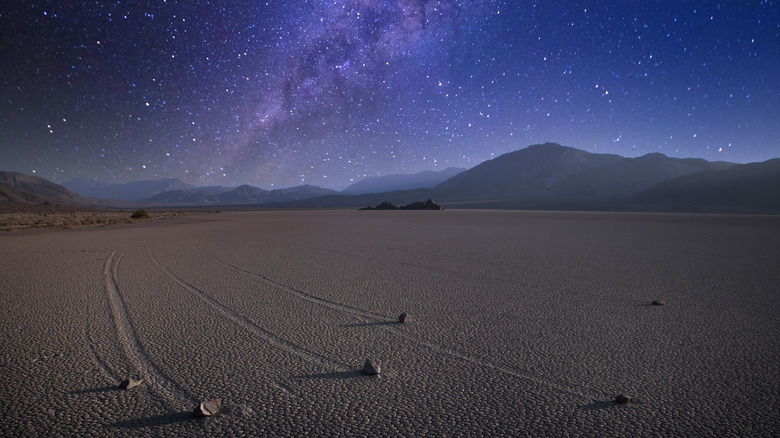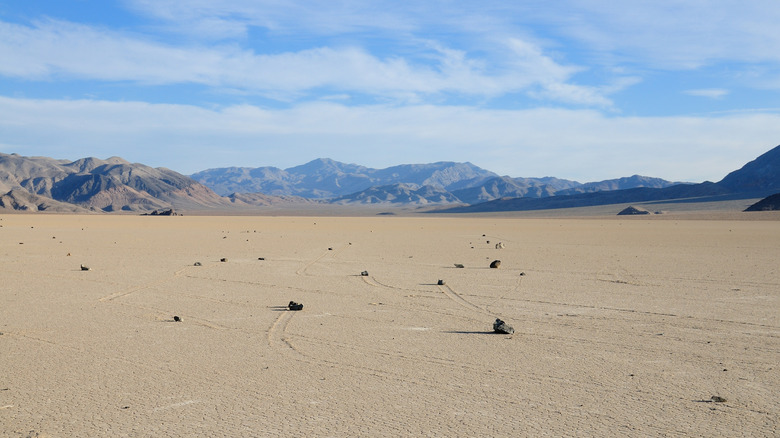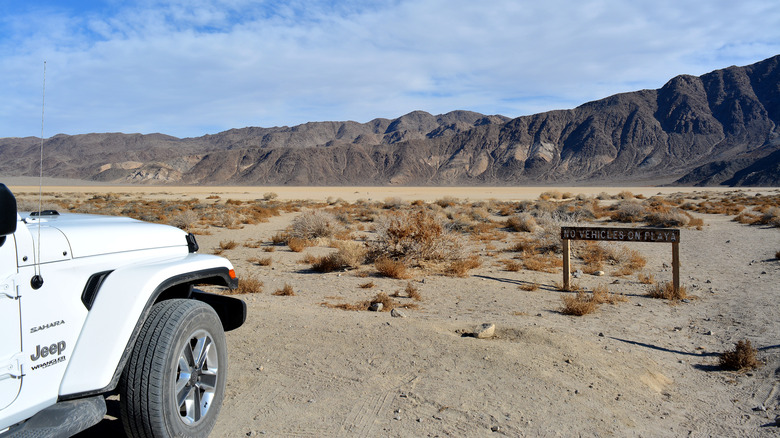A Stunning And Desolate California Landscape's 'Sailing Rocks' Are A Deep Mystery
The allure of some of the most mysterious places around the globe lies in humanity's endless fascination with the unexplained. Sites like Stonehenge in England or the Great Blue Hole in Belize captivate us, blending natural beauty with enigmatic origins. Among these wonders is Racetrack Playa in California's Death Valley National Park — one of the world's most dangerous parks — where "sailing rocks" seemingly move on their own, leaving behind trials that defy explanation.
Nestled in one of the world's most extreme environments, Racetrack Playa is one of the surreal Mars-like landscapes you can experience in this region. Death Valley, renowned for its blistering heat and otherworldly scenery, draws intrepid explorers seeking the unusual. The "self-moving" rocks situated on the surface of the cracked lakebed have long been one of the park's most compelling mysteries and have inspiring strange theories that range from natural phenomena to extraterrestrial intervention.
Racetrack Playa's sailing stones remain a testament to the power of nature's mysteries and the dedication of those who seek to understand them, as well offering a glimpse into the interplay of natural forces sharing our planet in the most surprising ways.
Theories behind Racetrack Playa's moving rocks
Known as "sailing stones," the rocks appear to glide across the playa, carving distinctive (sometimes synchronized) trails in the mud, something rarely seen anywhere else in the world. Spanning up to three miles long by two miles wide, the dry, cracked expanse resembled an alien landscape. Visitors describe a visit as awe-inspiring, with one Tripadvisor reviewer noting: "You have to be kind of a nerd to appreciate what is here... Hike out about a mile or so to see the rocks with their long tails, and sit in awe of how it all happens!"
The phenomenon has been studied for close to a century, with some rocks being large and heavy, weighing up to 700 pounds and traveling as far as 1,500 feet. Early theories attributed their motion to magnetic fields, strong winds caused by hurricanes, dust devils, or even animals. More whimsical hypotheses suggested aliens or supernatural forces at work. This effortlessly photogenic site has and will continue to inspire a sense of wonder.
Has the mystery been solved?
In 2014, researchers cracked the case using specialised equipment such as weather monitoring equipment and trackers. They discovered that a rare combination of environmental conditions allows the rocks to move and create imprints on the sediment. After rainfall, the lakebed becomes a shallow pool, often just a couple of inches in depth, which freezes over in the winter months, trapping the rocks in thin layers of ice. As the temperature rises and the ice melts, gentle winds push the ice sheets and apply just enough force to slide them across the slick surface, leaving behind their distinctive trails.
This natural phenomenon requires the perfect timing of rain to form the pool initially, then being followed by freezing temperatures to create the ice, and then the right wind speed to move the rocks forward. Witnessing the process in real time is extraordinarily rare.
Accessing Racetrack Playa is an adventure in itself. The 82 mile drive from Furnace Creek Visitor Centre takes over three hours, with much of the journey on rough, unpaved roads requiring a high-clearance 4x4 vehicle. The route passes through stunning landmarks, including Grandstand and Ubehebe Crater, offering breathtaking scenery along the way. Visitors should prepare for the journey carefully, as there is no cell phone service in the area. A GPS device or physical maps is essential. Once at the site, cars must be left in designated parking areas and are strictly forbidden from being driven on the lakebed. Walking on the lakebed also requires caution to avoid damaging its surface or disturbing the rocks.


